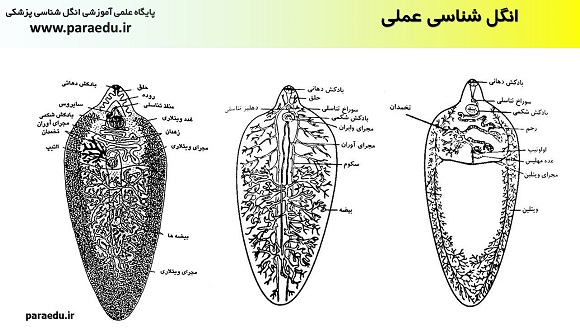فاسیولا هپاتیکا و ژیگانتیکا دو انگل مهم از ترماتودهای کبدی هستند که معمولا در مباحث آزمایشگاه انگل شناسی برای همه رشته ها تدریس می شوند.
در این فایل که جهت دانلود در اختیار شما قرار داده شده است مباحث زیر قرار داده شده است:
- کرم بالغ فاسیولا هپاتیکا
- کرم بالغ فاسیولا ژیگانتیکا
- تخم فاسیولا
موارد فوق با تصاویر مختلف و شکل های شماتیک و با توضیحات برای هر کدام ارایه شده است.

دانلود فایل اسلاید های فاسیولا هپاتیکا و فاسیولا ژیگانتیکا:
پیشنهاد مطالعه بیشتر درمورد فاسیولا هپاتیکا و ژیگانتیکا:
فاسیولا هپاتیکا و ژیگانتیکا به زبان انگلیسی
Fascioliasis: A Parasitic Disease Caused by Liver Flukes
Fascioliasis is a parasitic disease that affects the liver and bile ducts of humans and other mammals. It is caused by two species of flatworms: Fasciola hepatica and Fasciola gigantica. These worms are also known as liver flukes because they have a leaf-shaped body and live in the bile ducts of their hosts.
In this article, you will learn about:
– life cycle of liver flukes and how they infect their hosts
– morphology of liver flukes and how to identify them
– pathology of fascioliasis and how it affects the health of the infected hosts
– diagnosis of fascioliasis and how to detect the presence of liver flukes
– treatment of fascioliasis and how to get rid of liver flukes
The Life Cycle of Liver Flukes
Liver flukes have a complex life cycle that involves two hosts: a definitive host (usually a herbivorous mammal) and an intermediate host (a freshwater snail). The definitive host is the one where the adult worms live and reproduce. intermediate host is the one where the larval stages develop.
The life cycle of liver flukes is as follows:
– adult worms live in the bile ducts of the definitive host (e.g., sheep, cattle, or humans) and produce eggs that are passed in the feces.
– eggs hatch in water and release miracidia, which are ciliated larvae that have two eye spots. The miracidia swim in search of a suitable snail host (e.g., Lymnaea or Galba).
– miracidia penetrate the snail’s body and transform into sporocysts, which are sac-like structures that produce more larvae. The sporocysts give rise to rediae, which are elongated structures that have an oral sucker. The rediae produce cercariae, which are tailed larvae that have an oral sucker and a ventral sucker.
– cercariae leave the snail’s body and swim in water until they find an aquatic plant (e.g., watercress or lettuce). They attach to the plant’s surface and encyst as metacercariae, which are dormant larvae that have a thick cyst wall.
– definitive host becomes infected by ingesting the metacercariae on the plant’s surface. The metacercariae excyst in the intestine and migrate through the abdominal cavity to reach the liver. They penetrate the liver tissue and mature into adult worms in the bile ducts.
The Morphology of Liver Flukes
Liver flukes have a distinctive morphology that helps them adapt to their parasitic lifestyle. They have a flat body that is dorsoventrally flattened (i.e., flattened from top to bottom) and leaf-shaped. They have an oral sucker at the anterior end (i.e., the front end) and a ventral sucker at the middle of their body. These suckers help them attach to their hosts’ tissues and feed on their blood.
The adult worms can measure up to 3 cm in length and 1.5 cm in width. They are usually brown or gray in color. They have a digestive system that consists of a mouth, a pharynx, an esophagus, two branched intestines, and no anus. adult worms have a reproductive system that consists of both male and female organs. The worms hermaphrodites, which means they can fertilize themselves or each other.
The eggs of liver flukes are oval, yellow-brown, and have an operculum (i.e., a lid) at one end. They measure about 0.13 mm in length and 0.08 mm in width. They have a thin shell and a single cell inside.
The miracidia
miracidia of liver flukes are ciliated, which means they have hair-like structures that help them swim. They measure about 0.15 mm in length and have two eye spots that help them sense light. They have a simple digestive system that consists of a mouth and a gut.
The cercariae of liver flukes are tailed, which means they have a long appendage that helps them swim. They measure about 0.5 mm in length and have an oral sucker and a ventral sucker that help them attach to their hosts. They have a simple digestive system that consists of a mouth, a pharynx, and an intestine.
The metacercariae of liver flukes are round, which means they have a spherical shape. They measure about 0.2 mm in diameter and have a thick cyst wall that protects them from the environment. They have no digestive system and no external features.
The Pathology of Fascioliasis
Fascioliasis is a disease that affects the liver and bile ducts of the infected hosts. The severity and symptoms of the disease depend on the stage and intensity of infection.
The acute phase of fascioliasis occurs when the immature worms migrate through the liver tissue, causing damage and inflammation. This phase lasts for about two to four months after infection. The symptoms include:
– Fever
– Abdominal pain
– Hepatomegaly (i.e., enlarged liver)
– Jaundice (i.e., yellowing of the skin and eyes)
– Anemia (i.e., low red blood cell count)
– Eosinophilia (i.e., high eosinophil count)
– Liver abscesses (i.e., pus-filled cavities in the liver)
The chronic phase of fascioliasis occurs when the adult worms reside in the bile ducts, causing obstruction and infection. This phase lasts for several years or even decades after infection. The symptoms include:
– Biliary colic (i.e., severe pain in the upper right abdomen)
– Cholangitis (i.e., inflammation of the bile ducts)
– Cholecystitis (i.e., inflammation of the gallbladder)
– Cirrhosis (i.e., scarring and hardening of the liver)
– Biliary carcinoma (i.e., cancer of the bile ducts)
The Diagnosis of Fascioliasis
Fascioliasis can be diagnosed by various methods that detect the presence of liver flukes or their products in the host’s body. These methods include:
– Stool examination: This method involves examining the feces of the infected host for eggs of liver flukes. This method is simple, cheap, and widely available, but it has some limitations. It can only detect chronic infections, not acute ones. It can also be affected by low egg production, intermittent egg shedding, or false positives from other parasites.
– Serology: This method involves testing the blood serum of the infected host for antibodies or antigens of liver flukes. This method is sensitive, specific, and can detect both acute and chronic infections. However, it can also be affected by cross-reactions with other parasites, persistence of antibodies after treatment, or lack of standardized tests.
– Imaging: This method involves using ultrasound, computed tomography (CT), magnetic resonance imaging (MRI), or endoscopic retrograde cholangiopancreatography (ERCP) to visualize the lesions or worms in the liver or bile ducts. This method is accurate, non-invasive, and can provide information on the extent and severity of infection. However, it can also be expensive, unavailable, or inconclusive.
– Biopsy: This method involves taking a tissue sample from the liver or bile ducts and examining it under a microscope for histopathology. This method is definitive, as it can confirm the diagnosis and identify the species of liver flukes. However, it can also be invasive, risky, or impractical.
The Treatment of Fascioliasis
Fascioliasis can be treated by anthelmintic drugs that kill the adult worms and some immature stages. The most effective drug is triclabendazole, which is taken orally as a single dose or two doses 12 hours apart. Other drugs that can be used are bithionol or praziquantel, which are taken orally for several days.
The treatment of fascioliasis can also involve supportive measures such as pain relief, hydration, nutrition, antibiotics, or surgery. These measures can help alleviate the symptoms and complications of infection.
 انگل شناسی پزشکی Medical Parasitology
انگل شناسی پزشکی Medical Parasitology






